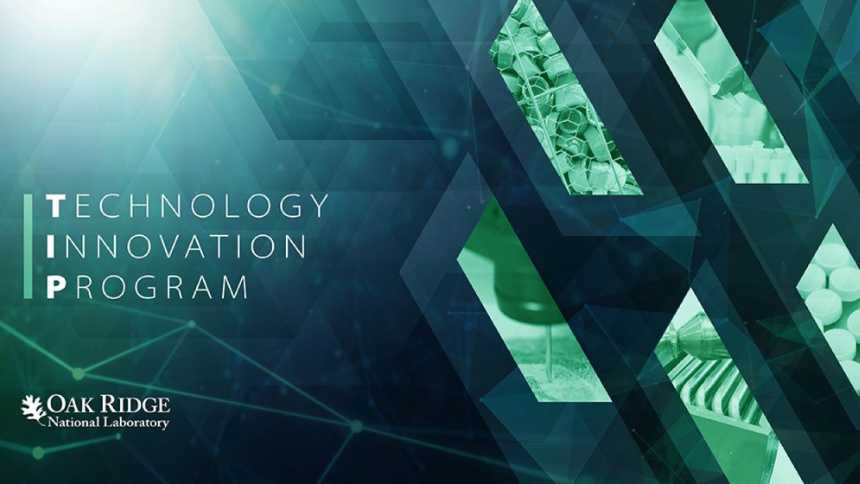
ORNL spotlights promising technologies during Friday event
Five of the seven inventions have received funding under the lab's Technology Innovation Program.
Seven promising technologies that could change the world were spotlighted Friday during the 2023 edition of the “Technology Innovation Showcase” at Oak Ridge National Laboratory (ORNL).
“We think that they have potential for commercial impact,” said Mike Paulus, the recently named Director of Partnerships who previously led the Technology Transfer group for about 14 years. And, to emphasize the importance of the event, ORNL Interim Lab Director Jeff Smith welcomed the in-person and virtual attendees where he noted his longtime interest in commercialization.
Five of the technologies are part of ORNL’s Technology Innovation Program (TIP) which is focused on accelerating commercial adoption of promising lab-developed technologies by making targeted investments that enhance commercial readiness and raise a technology’s visibility. Paulus noted that ORNL has invested more than $11 million in 49 TIP projects since 2012. Those investments have resulted in 37 commercial licenses and options with partners ranging from Fortune 100 companies to early-stage start-ups.
The technologies that are part of the TIP portfolio, the individual presenting them, and a brief description were:
- The Ultraclean Condensing Furnace has the potential to revolutionize the residential heating market. That’s because the majority of the 118 million homes in the U.S. rely on natural gas furnaces even though the acidic components in furnace combustion gases pose a significant environmental challenge. As described by Zhiming Gao, a Senior in the Buildings and Transportation Science Division, the patent-pending technology can remove more than 99.9 percent of acidic gases and other emissions, including trapping more than 95 percent of sulfur oxide and reducing more than 95 percent of nitrogen oxide.
- The Rapid Droplet Sampling Interface (RDSI) is a versatile, ultrahigh-throughput, and ultralow-volume chemical analysis method that can address a variety of research industries, including the pharmaceutical, biochemical, clinical, and environmental sectors. The RDSI technology addresses the sensitivity, speed, and material cost shortcomings of competitive rapid analysis technologies by providing ultrahigh-throughput chemical analysis while drastically reducing associated costs. As described by Vilmos Kertesz, a Researcher and Development staff member in the Biosciences Division, it will allow quicker turnaround in both pharmaceutical and clinical laboratories that in turn can yield faster drug discovery and disease diagnosis. A patent was issued on May 16, 2023.
- Meghan Lamm, an Associate Research and Development staff member in the Manufacturing Sciences Division, described a critical need in the buildings sector for energy-efficient, slim, low-cost, and robust building envelope solutions to help maintain thermal comfort. Based on industrially relevant processes, ORNL has developed the Closed-Cell Thermoset Foam Insulation technology that combines dual hollow filler materials embedded in a thermoset matrix. Two patent applications have been filed on the technology that would decrease end-use energy consumption and allow for increased indoor space by reducing the thickness of building components, a valuable aspect for consumers.
- Plastic waste management has become a global environmental crisis with roughly 80 percent of the more than 400 metric tons of plastics produced annually improperly discarded. That equates to $100 billion worth of materials being lost. Only nine percent of plastic waste is recycled, most of which is downcycled into lower-value products. Plastic waste-to-product solutions that are efficient and cost-effective are needed to convert plastic trash to clean value-added commodities. As described by Tomonori Saito, a Senior Scientist in the Chemical Sciences Division, ORNL’s patent-pending mixed plastic recycling technology can be used to deconstruct various types of plastic waste such as bottles, packaging, foams, mattresses, protective gear, automotive components, textiles, and more into chemicals, which can be made into virgin polymers. Other plastics that are not deconstructed in this process can be filtered, collected, and reused.
- Jerry Parks, a Senior R&D Scientist in the Biosciences Division, described work by a team of researchers to address the critical need for new antiviral drugs for treating infections of severe acute respiratory syndrome-coronavirus-2 (SARS-CoV-2). New drugs are crucial for rapid therapeutic response to COVID-19, supporting ongoing vaccination campaigns, and expanding future antiviral drug options. Through rational and computational design, the ORNL team developed a potent and selective covalent inhibitor of the papain-like protease (PLpro) of SARS-CoV-2. Why is that important? PLpro is a critical target because it is essential for viral proliferation and dysregulates the host immune response. It is a patent-pending technology.
The non-TIP technologies were:
- Building leakage accounts for about 4 quadrillion British thermal units of energy consumption in the U.S., contributing to poor indoor air quality, occupant comfort, and building material durability. Locating and sealing leakage sites is critical to saving energy and to improving indoor building conditions and durability. Philip Boudreaux, a Researcher in the Building Envelope Materials Research Group, described a technology that utilizes background oriented schlieren (BOS) photography to detect shifts in background texture to visualize transparent fluid flow in a sequence of images. A patent application was filed in March 2023.
- Wellington Muchero, Senior Staff Scientist and Geneticist in the Biosciences Division, presented another technology related to SARS-COV-2. According to information provided to attendees, a specific group of proteins – an immunostimulant – increases or enables the ability of a cell to respond to a foreign entity. However, the presence of an immunoregulatory protein suppresses the ability of a cell to respond. Because of this suppression process, cells do not possess the ability to fight against invasive pathogenic fungi or viruses. Inactivation of the immunoregulatory protein in a cell increases the likelihood that the cell can respond to a foreign entity. The ORNL team successfully demonstrated that inactivating the PAN domain inhibits spike protein binding in a receptor of the SARS-COV-2 virus.
To learn more about any of the technologies, you can review a booklet prepared for attendees (2023 TIP Program Brochure).
Like what you've read?
Forward to a friend!

